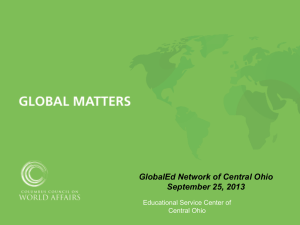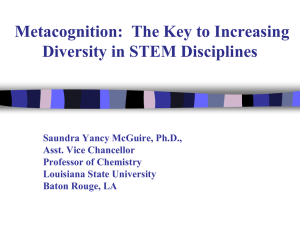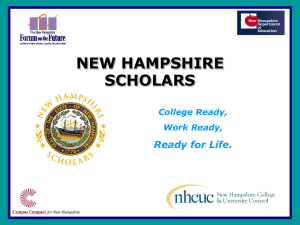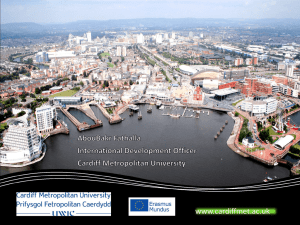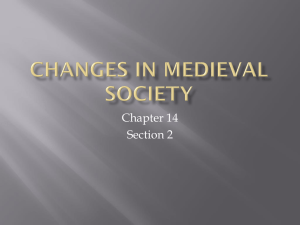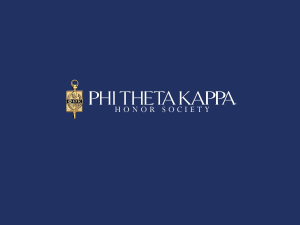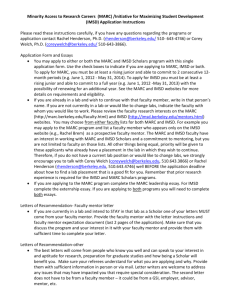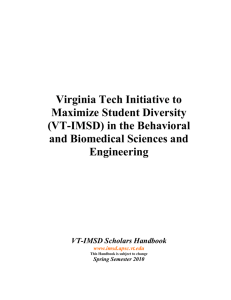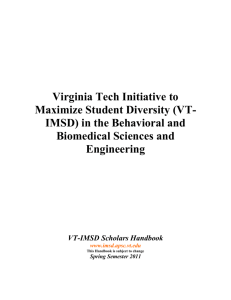University of Washington (UW)
advertisement
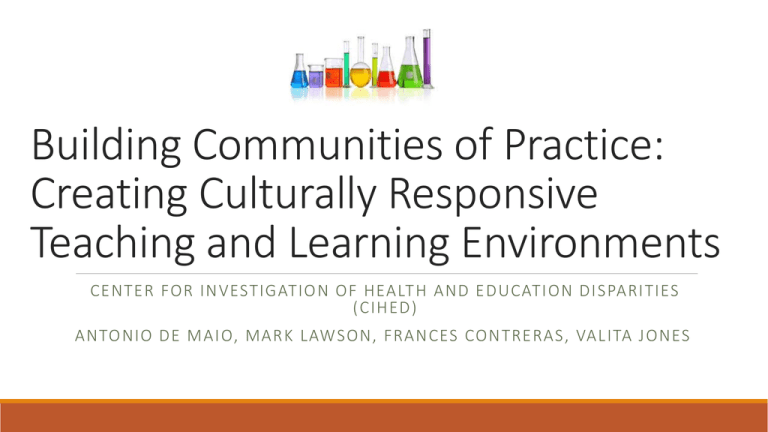
Building Communities of Practice: Creating Culturally Responsive Teaching and Learning Environments CENTER FOR INVESTIGATION OF HEALTH AND EDUCATION DISPARITIES (CIHED) ANTONIO DE MAIO, MARK LAWSON, FRANCES CONTRERAS, VALITA JONES Be a part of co-constructing the conversation Be patient with each other Communicate authentically with meaning and respect Remain in a place of understanding AN INVITATION TO GROW… Expected Learning Outcomes Understand the principles of culturally responsive teaching and why it is important to embrace the concepts of learning from this perspective. Learn how to develop an innovative learning community that is science based and culturally responsive. Be able to translate contemporary educational theory into successful practice. Learn how instructional theory can be used for developing successful and effective teaching strategies. Learn the principles for creating a pedagogy for success and achievement by forming a learning environment ecosystem. Bring theoretical knowing and practical knowing together in the construction of achievement and student-centered curriculum. Understand how to develop a unified system of practice for educational achievement and social development. Thinking Differently… “Schooling is a process intended to perpetuate and maintain the society’s existing power relations and the institutional structures that support those arrangements. Education, in contrast to schooling, is the process of transmitting from one generation to the next, knowledge of the values, aesthetic, spiritual beliefs, and all things that give a particular cultural orientation its uniqueness.” Mwalimu Shujaa The IMSD program was established in 2008 at UCSD and is funded by the National Institutes of General Medical Sciences (NIGMS). The goal of the IMSD program is to motivate, mentor, and facilitate the transition of students from disadvantaged economic and social backgrounds and students with disabilities from college education to Ph.D. programs in the sciences. The UCSD-IMSD program is composed of three consecutive phases starting with training during the first years of a student’s college education, followed by hands-on research experience, and ending with the awarding of a Ph.D. degree in biomedical sciences. IMSD PROGRAM Undergraduate Program Components Basic Methodology Training Laboratory IMSD Interdependent Lab Research Phase 1. Basic Methodology Training Laboratory (BMTL): Students with no or limited prior research experience are introduced to scientific work via fundamental experimental instruction within the BMTL. In this setting, students learn the essential research principles and skills (laboratory safety, basic techniques, data collection, and analysis) that will prepare them to participate in organized independent research projects. During the 14 week training period, students learn several stateof-the art techniques and participate in a small research project under the supervision of an advanced graduate student. Phase 2. Independent Research Project: Students participate in hands-on, bench research projects under the mentorship of established, well-funded investigators. Students are trained in several aspects of science, including experimental design, execution, data analysis and presentations, which increase their competitiveness as graduate school candidates. Students participate in an independent research project as well as typical laboratory activities, such as group meetings and journal clubs. Students are encouraged to present their projects at national meetings or in peerreviewed publications. Scholars are assisted in the preparation of strong graduate school applications. Graduate Component Phase 3. Graduate School Education: Students that enroll into a UCSD graduate program in the areas of biomedical research, biological sciences, neuroscience, bioengineering, and bioinformatics are supported during their first year of graduate education and assisted in their applications to individual fellowships and in the search for professional activities upon graduation, such as postdoctoral training. Student Participant Demographics Eligibility: a student must meet the following criteria: 1) be a U.S. citizen or permanent resident; 2) come from a socio-economically disadvantaged background (a disadvantaged background includes coming from an environment that has inhibited the individual from obtaining the knowledge, skills, and abilities required to enroll in higher education and/or living in a household with an annual income at or below established low-income thresholds according to family size published by the U.S. Census Bureau) or be from a group that is underrepresented in the biomedical sciences (African-American, Hispanic, American Indian, Native American, U.S. Pacific Islander), or have a demonstrated disability. Orientation KNOW YOUR STUDENTS…CULTURE GIVES REALITY MEANING… Teaching As Relevant… “Teaching is a complex and multidimensional process that requires deep knowledge and understanding in a wide range of areas and the ability to synthesize, integrate, and apply this knowledge in different situations, under varying conditions, and with a wide diversity of groups and individuals” Etta Hollins Sustainability = Ordered Reality Cosmology – structure of the thinking Epistemology – how they know Axiology – what they value Logic - how they create meaning base on the thinking and knowing and organize it Cultural Frameworks Ontology – the nature of what they know “Culture is a process which gives people a general design for living and patterns for interpreting their reality” Wade Nobles, 2006 ASILI - INFORMS THE VALUES AND BELIEFS – ULTIMATELY THE WORLDVIEW – CREATE MEANING AND MOVEMENT TOWARDS GOALS Why is Culture Important to the Process of Learning? Core of their DNA-blueprint Culture is a people’s immune system Promotes interconnectivity and transformation Promotes understanding and meaning making Guides a people’s worldview, paradigms and ideology Improves a people self-confidence and self-efficacy Is not static---it is a living influence that consistently evolves Foster’s innovation Why Bother With Understanding Cultural Thinking And Consciousness? Understand The Students Principles for Living Informed by the students values, ideology, and experiences. Understand their specific agency (motivation/ movement). To Interpret the Student Thinking Understand the students principles for living and how it influences their level of consciousness. Interpret how to teach and meet the students needs. Teach for Understanding Construct knowledge in such a way as to be relevant and responsive to the manner in which students learn. Access and stimulate the students multiple intelligences. Become multidimensional in teaching pedagogy and curriculum development in regards to how you transmit knowledge and information and motivate students to learn and apply content knowledge. Culturally Responsive Teaching is adjusting how we teach to the needs and experiences of students by using their cultural knowledge, prior experiences, frames of reference, and performance styles to make learning encounters more relevant and effective for them…. Culturally Responsive Teaching Culturally responsive instruction promotes excellent and personal meaning in education for culturally diverse students. Acknowledges that each student is part of a learning community. Recognizes that students’ real-life experiences and cultural traditions (Thinking, Values & Beliefs) can play a role in the learning environment. Accepts that students bring with them knowledge and experience that are essential to THEIR construction of knowledge and meaning making (Understanding). Understands that each Professor/Researcher (PI) beliefs about teaching and learning have a significant impact on how they teach, what they teach, and what they believe to be qualify as learning. Helps students to make sense of their own communities and the larger world, and define and create their own reality as developing scientist. Shows a demonstrated commitment to historically underrepresented populations. Putting Our Research Skills to Use! What skills am I being called to develop? What is the current pedagogy and curriculum rooted in ( whose thinking)? What is the relatedness to what you are teaching to the students realty? How is what you are teaching being interpreted and learned? What lens are my students using to form meaning? Generally speaking how does my population know what they know? How has their knowledge been constructed? How is any of this (teaching pedagogy, curriculum design, activities) relevant to the learning process for my students? After Becoming Responsive… Assist in Creating Intellectual Leaders in the classroom. Support students as apprentices in a learning community. Understand that students come to the learning environment with knowledge and information already and learn how to build on that knowledge capital. Assist students in learning to become interpretive and negotiate their learning and research experience for positive achievement. Change your thinking from status quo to innovative and become conscious and aware. Recognize your role as being political and part of social justice in reference to equity and equality. Creating the Community IMSD PROGRAM Individual vs Collective Value System Framework INDIVIDUALISM COLLECTIVISM 1. Foster independence and individual achievements 1. Fostering interdependence and group success 2. Promoting self-expression, individual thinking, personal choice 2. Promoting adherence to norms, respect for authority/elders, group consensus Associated with egalitarian relationships and flexibility in roles (e.g. upward mobility) Understanding the physical world as knowable apart from its meaning for human life Associated with private property, individual ownership 3. Associated with stable, hierarchical roles (dependent on gender, family background, age) 4. Understanding the physical world in the context of its meaning for human life IMSD Program Core Values System of Practice and Application (Unified System of Pedagogy & Practical Application). Incorporates a Meaningful and Purposeful Learning Community. Requires Cooperation & Collaboration Promotes Interdependence not Individuality Supports Self-determination and Unification Suggests Creativity, Innovation, Critical Thinking, and Reflection Stewards Meaning Making By Teaching For Understanding Content Knowledge is Constructed Through Culturally Relevant Instruction, Teaching and Practice. The Foundation For The Learning Community is Grounded in Relevant Teaching and Learning Praxis. Learning Is Situated Through Activities In The Lecture and Laboratory – This allows for the Development of Science Confidence. Content Knowledge and Information is Connected Through Application. A major disadvantage for applicants to Ph.D. programs is a lack of research experience, which is elevated in candidates coming from small colleges in which the richness of research experiences is limited. Connected Teaching and Practice Creates a Culturally Responsive Learning Environment that Integrates Historical, Cultural, Political, and Developmental Considerations of Research Into A Unified Pedagogical Theory and Practice For Maximum Student Learning and Achievement. Curriculum and Lab Pedagogy How to Create the Learning Experience? Our program includes several novel approaches, including an introductory course where scholars are taught laboratory safety, the ethical conduct of research, and critical scientific reading. In addition, Scholars also participate in activities directed at increasing their scientific reading and writing. Moreover, scholars will participate in workshops directed at increasing their motivation, self-confidence, and communication skills. After completing their training, BMTL participants are placed in different laboratories where they do hands-on bench research and participate in the various typical activities of any research group. Several undergraduate students participating in the IMSD program have published in peer-reviewed journals. In addition, students partake in regular activities that further encourage their interest in pursuing Ph.D. degrees in science, such as scientific journal clubs where they increase their awareness and ability to understand scientific literature. Lecture Structure Knowledge Construction Opportunities-Scholars are prepared in basic laboratory techniques (e.g., cloning, Western blotting) and develop fundamental skills (e.g., keeping a laboratory record book), which is followed by state-of-the-art training (e.g., flow cytometry, quantitative PCR) and a practical course in biostatistics. Laboratory Structure Moving From Theory to Practice-Freshman students participate in a Basic Methodology Training Laboratory (BMTL) that exposes them to basic research techniques and common scientific practices. . Each student receives individualized training from an instructor. In addition, scholars learn the principles behind each technique. In addition to training and preparing students for success in laboratory research, the BMTL also improves students’ academic performance. Student Disposition As A Developing Scientist-The BMTL helps students overcome the biggest concern that investigators have about accepting undergraduate students into their research groups, which is the lack of laboratory experience. In addition, the BMTL experience results in a positive interaction among participants, creating a dynamic environment and camaraderie. Performance Feedback (Learning Loop-Reflection)-Students will be monitored by a panel of three faculty members, including the principal mentor, who at the end of the training period will recommend the candidates for acceptance into graduate programs. Finally, scholars will be assisted in their applications to Ph.D. programs across the country through a structured counseling system. Module Example Module 1. Molecular, Cell Biology and Biochemistry (Weeks 1-6) Week 1: Protein concentration assay 1) The use of a pipettor (practice using water and a balance). 2) Lecture on protein concentration assay: the importance of determining protein concentrations Description of the different colorimetric protein assays commonly use in research laboratories (Bradford, Lowry or bicinchoninic acid). 3) Measurement of protein concentrations using the colorimetric BCA assay with BSA as standard. Preparation of a standard curve using serial dilutions. Scholars learn how to use a spectrophotometer and how to analyze results (plot a standard curve and determine protein concentration using standard Excel software to perform a regression and plot). 4) Scholars perform protein concentration determination of an unknown sample under minimal supervision. Three unknown protein samples are provided to each student. Protein concentration in each sample is determined in triplicate (provides instructor with the student ability to pipet in a reproducible manner). Data are analyzed and reported in laboratory notebook. Scholars will repeat this procedure until they master the technique. Scholars are considered capable when triplicates are within a 0.03 OD range (pipetting), and the standard curve coefficient of determination R2 is 0.9 or above (pipetting and dilution). Sample of Seminars How to Create a Research Action Plan - This seminar will focus on assisting the scholars in preparing a research platform statement and finding potential schools and specific faculty Ph.D. mentors. The use of computer assisted search of literature (e.g, use of PubMed). How to Apply to Graduate School - This seminar will focus on assisting scholars with preparing a winning graduate school application. Emphasis will be placed on how to write an effective statement of purpose and request excellent letters of recommendation. What Happens After I Apply? - This workshop will focus on helping scholars understand the cycle of the application and admittance process. The Doctorate Student’s Survival Guide – This seminar will include a panel of current Ph.D. candidates sharing their experiences of how to be self-retained and survive graduate school to degree completion. Critical information will be shared on developing coping techniques and identifying potential funding streams such as NIH and NSF fellowships. Building a Community of Peer Support - Scholars will learn the importance of and be introduced to digital scientific communities, such as AAAS, MySciNet and CtScieNet, that offer mentor support and serve as resources Branding Yourself as a Scientist - The focus of this workshop is to assist scholars in building a digital portfolio as a scientist using social media as a marketing tool. Conducing Poster and Oral Presentations - Scholars will be instructed on how to present their research findings both orally and at poster presentations. The Dissertation Explained - An overall review of the process of writing a dissertation and picking an effective committee. Peer to Peer Networking Annual Retreat: At the end of each academic year, all of the scholars in the program will get together with participating mentors to present the results of their work at an annual retreat. This retreat will be held in conjunction with the UCSD-IMSD and UCSD-MARC programs to increase the exposure of the scholars to a rich scientific environment. Scholars will given the opportunity to discuss their results in either an oral or poster presentation. In addition, part of the time during this retreat will be used to discuss student experiences, particularly those ideas that will help improve the program. In addition, PREP scholars will attend the annual retreat of at least one participating UCSD graduate program to expand their research horizons. These activities will increase the interaction of PREP scholars with graduate students and faculty members. Lunch with a Graduate Student: During the academic year, participating scholars will have a bi-monthly lunch with one or more graduate students who are close to fulfilling their Ph.D. requirements. The goal of these meetings will be to share the experience of successful investigators and graduate students with the scholars in an informal environment. Some of these meetings will be also used to discuss funding opportunities (pre-graduate and post-graduate) and the preparation of successful applications for graduate school, postdoctoral, and faculty positions. Ubuntu Mentoring Program: Throughout the year, scholars will participate in the peer mentoring program where new participants are paired with current program participants. This program offers support and the ability for newly developing scientist to develop social capital, networks and peer support for one another. Understanding A Connected Practice… Theory – Culturally Responsive Teaching/ Constructivism Culturally structured thought helps to guide and shape the curriculum and pedagogical practice. Learn and absorb that cognition is determined through patterns. Framework – Anti-deficit Framework Underrepresented student populations are viewed through a lens of potentiality and possibility, rather than defeat and incapable of learning or developing as scientist. Praxis – BMTL Experience and Interdependence Research Experience Students are more academically prepared and mentored. They are integrated and expose to meaningful research. Students are retained, demonstrate stronger self-identity as scientists, become more consciousness and can navigate their way to graduation. Program Evaluation Design Evaluation Questions The research questions of this study include: 1. In what ways has the IMSD program influenced the academic performance and tangible STEM related skills of student participants? 2. Has the IMSD program influenced student aspirations for graduate school and career goals? 3. Has the IMSD program influenced the mentorship approaches of IMSD faculty? In what ways has the program served as the foundation for engaging faculty to mentor minority undergraduates? Have faculty mentorship practices been influenced as a result of their participation as an IMSD mentor? IMSD Students Supported More than 103 undergraduate students have entered the Basic Methodology Training Lab since the inception of the program Phase II of the program has placed many students in independent labs and IMSD undergraduate students get published! Academic Grades improve for students after the BMTL Increased number of faculty wanting to mentor IMSD students because they are well prepared Student build science confidence Mentors are engaging students and offering career advise Currently, there are 16 former IMSD students in Ph.D. programs around the country. Where Are IMSD Students? University of California, San Francisco (UCSF) Cornell University University of California, San Diego (UCSD) Yale University University of California, Irvine (UCI) Duke University University of California, Los Angeles (UCLA) Massachusetts Institute of Technology (MIT) University of California, Riverside University of Texas, Austin (UT) University of Southern California (USC) UT Southwestern Kellogg School - Scripps Research Institute Gerstner Sloan Kettering University of Washington (UW) University of North Carolina, Chapel Hill University of Georgia California Northstate University College of Pharmacy (CNUCP) Columbia University University of Washington (UW) Questions? “Cultural Pluralism promoting a more pluralistic society by encouraging rather discouraging ethnic identity movements and the women’s movement, encouraging them not to abandon, but to get ever more deeply in touch with their inner core” Dave Malcom

